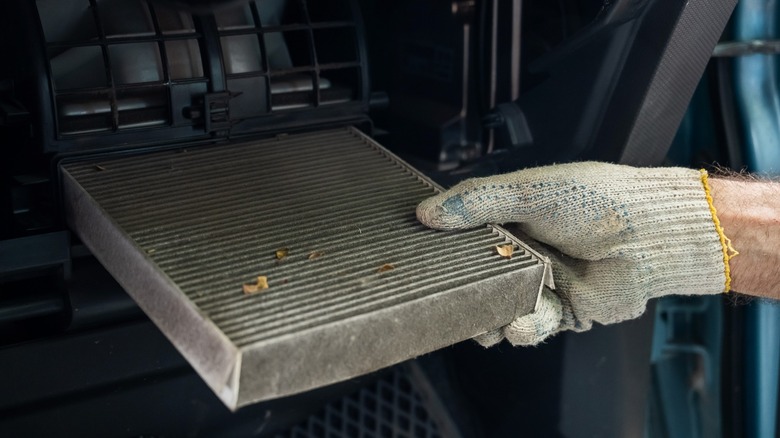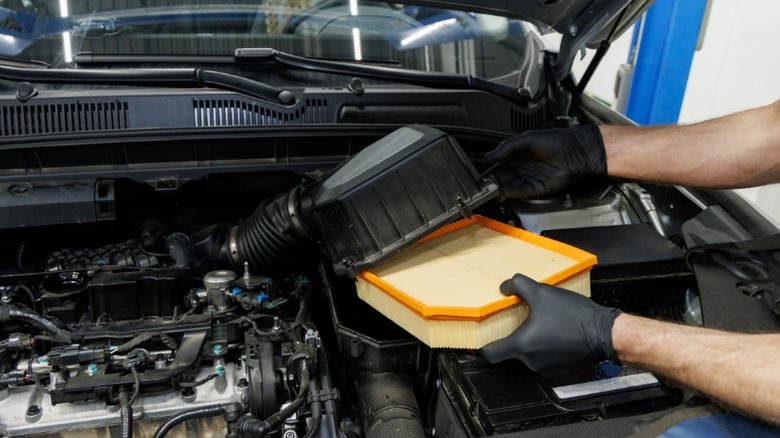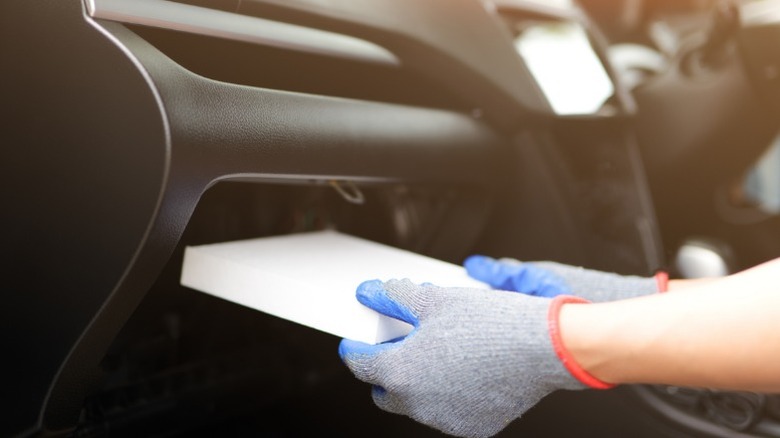Engine Air Filter Vs. Cabin Air Filter: What's The Difference?
If you drive a car with an internal combustion engine, which is most modern vehicles that run on fossil fuels, then your engine requires a precise combination of fuel and oxygen to function properly. That mixture of fuel and oxygen is necessary to feed the tiny explosions responsible for moving the pistons up and down, rotating the crankshaft and camshaft(s), and sending power to various other parts of the vehicle, including the transmission and your wheels.
But while clean air is an essential ingredient for your engine's healthy operation, the engine isn't the only part of your car that requires a fresh stream of oxygen. It's also important for you and your passengers to have clean air to breathe while driving or riding in the vehicle. For times when you don't want to or can't roll your windows down, the car's HVAC system is responsible for sending air to the cabin.
Your vehicle's HVAC and engine air intake systems both work by drawing in air from the environment around the car. Unfortunately, the air around us isn't always clean. To combat pollutants, like debris and allergens, our vehicles' engine air intake and HVAC systems rely on filters. These devices help prevent some of the most harmful substances from entering our engines and car cabins. However, while many people are aware of their car's engine air filter, many others don't know about the cabin air filter. These two components are not the same thing, but it is important to maintain them, which means learning about their functions, locations, and replacement schedules. Fortunately, as a former professional mechanic, I'll break it down for you. Here's everything you need to know about cabin air filters and engine air filters.
What is an engine air filter?
As the name implies, your car's engine air filter is responsible for cleaning the air that enters the engine through the air intake system. The system sucks in air from the front of your vehicle near the grille. That outside air then passes through the engine air filter, which prevents contaminants and debris, like dust, pollen, insects, and plant material, from getting into the engine.
Engine air filters can be constructed of various materials, depending on the type of vehicle and the filter's application. Common filter materials include paper, cotton, synthetic fabrics and foams, as well as metal mesh. Many engine air filters also come with a built-in gasket or seal. You can usually find your car's engine air filter in a plastic housing or box near the engine, and it will typically be connected to the air intake tubing on one end and another set of tubing on the other side leading to the engine throttle body.
Your engine air filter may seem like a relatively insignificant and innocuous component, but it's a vital part of the intake system. As such a critical component, it requires regular maintenance. Depending on your car and the area in which you live, most automakers recommend replacing the engine air filter every 10,000 to 15,000 miles. In addition, you should inspect the filter regularly and any time you replace the oil. When it comes to changing the engine air filter, it's a pretty easy task, and one of the best DIY auto jobs for beginners. While not a pricey procedure, even at a shop, it's worth trying out at home to save a few bucks, and it could be a great way to learn more about your car.
What is a cabin air filter?
If you drive a relatively modern car, chances are it has a cabin air filter. Like the engine air filter, the cabin air filter is responsible for cleaning the air that enters the vehicle. They're designed to prevent contaminants like pollen and dust from getting into your car's cabin and polluting the air you and your passengers breathe. Some cabin air filters even come with HEPA-rated protection to guard against microscopic bacteria and other pollutants.
Cabin air filters can be built from materials like paper in the case of particulate filters, activated charcoal, and specially-engineered fabric that contains an electrostatic layer to trap things like cigarette smoke and diesel emissions. Cabin air filters tend to be smaller than engine air filters and are usually located on the passenger-side of the car behind the glove box compartment or in the dashboard.
As is the case with your engine air filter, you also need to maintain your cabin air filter regularly. Most experts recommend replacing the cabin air filter every 15,000 to 20,000 miles, depending on where you live and your vehicle. However, you should check your owner's manual to confirm replacement intervals, and you should also check the cabin air filter regularly, or at least every time you replace the engine oil. That said, replacing the cabin air filter is a bit more complex than changing the engine air filter. As mentioned, the cabin air filter's location can vary depending on your car, but it's commonly housed behind the glove compartment. Accessing the cabin air filter can be tricky if you're an automotive novice. However, it's definitely doable with the right guidance and is another great way to learn more about your vehicle while performing a vital maintenance task.


